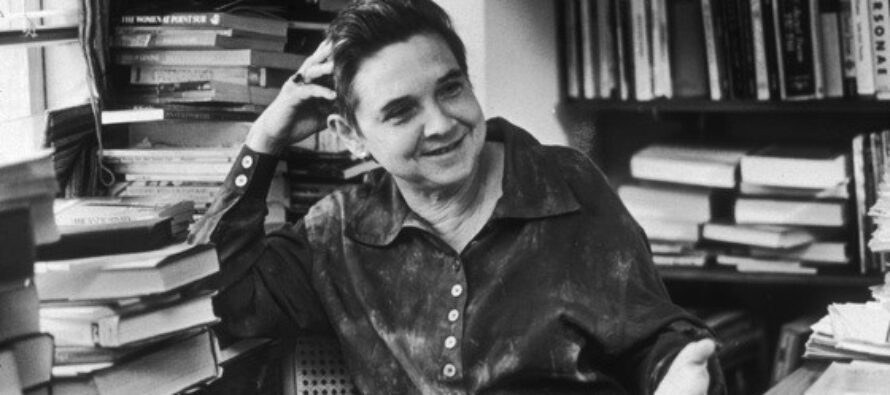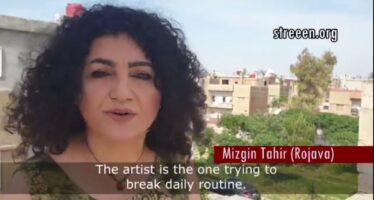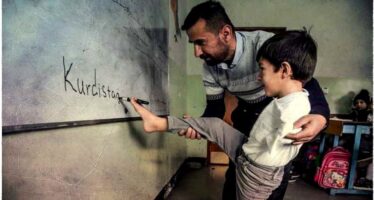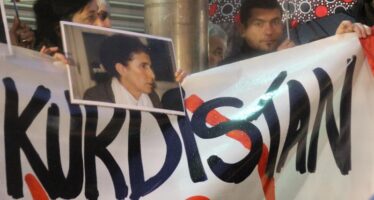Adrienne Rich: “Defy the Space That Separates ”

![]()
I never expected to edit a contemporary poetry anthology. When David Lehman, the series editor for Best American Poetry, asked me to undertake a volume, I was dubious — about the title and its implications, about the “catchment area” I could possibly hope to survey, about the usefulness of the project, not only for me but for poetry itself. Who would read it, how would it serve? My decision finally rested on Lehman’s guarantee of complete editorial independence, which he honored throughout the selection process.
And so The Best American Poetry 1996 belies its title. From the first I pushed aside the designations “best” and “American” (surely in the many Americas there are many poetries). Rather, I visualized a gathering of poems that one editor, reading through mailboxesful of journals that publish poetry, found especially urgent, lively, haunting, resonant, demanding to be reread. By temperament, experience and lifework I’ve been drawn over the past six decades to many kinds of poetry, not always comparable to one another; toward certain kinds of claims for poetry. These inclinations are without doubt reflected in my choices.
But also reflected in this collection — both by what’s here and by what is not — are the circumstances of North America (reaching into Mexico) in a decade that began with the Gulf War and that has witnessed accelerated social disintegration, the lived effects of an economic system out of control and antihuman at its core. Contempt for language, the evisceration of meaning from words, are cultural signs that should not surprise us. Material profit finally has no use for other values, in fact reaps benefits from social incoherence and atomization, and from the erosion of human bonds of trust — in language or anything else. And so rapid has been the coming-apart during the years of the nineties in which these poems were being written, so stunned are so many at the violence of the dismantling (of laws, protections, opportunities, due process, mere civilities) that some of us easily forget how the history of this Republic has been a double history, of selective and unequal arrangements regarding property, human bodies, opportunity, due process, freedom of expression, civility and much else. What is new: the official recantation of the idea that democracy should be continually expanding, not contracting — an idea that made life more livable for some, more hopeful for others, caused still others to rise to their fullest stature — an appeal to the desire for a common welfare and public happiness, above the balance sheets of profit.
“Poetry,” John Berger has written, “can repair no loss, but it defies the space which separates…by its continual labour of reassembling what has been scattered.” As I read throughout the year, I found myself asking, What does it mean for poets when so powerful an idea, prescription, vision of the future — however unrealized — is abruptly abandoned or driven underground? Increasingly it seemed to me that it’s not any single poem, or kind of poem, but the coming together of many poems, that can “reassemble what has been scattered,” can offer, in Muriel Rukeyser’s words, “the truths of outrage and the truths of possibility.”
In selecting the poems, I read through a great many literary and cultural journals, requested many others. Early on I sensed that the poetry I was searching for would not be confined to the well-known journals. But I read them in a spirit of hope and discovery, and was sometimes well rewarded. I also sought out many local and regional publications, as well as nonliterary periodicals that publish poems occasionally.
Let me say here what, overall, I was looking for.
I was listening, in all those pages and orderings of words, for music, for pulse and breath, for nongeneric voices.
I was looking for poems with a core (as in corazon). The core of a poem isn’t something you extract from the poem’s body and examine elsewhere; its living energies are manifest throughout, in rhythm, in language, in the arrangement of lines on the page and how this scoring translates into sound. A great many poems rang hollow and monotonous to me; at best they seemed ingenious literary devices, at worst “publish or perish” items for a vita or an M.F.A. dissertation — academic commodities.
I was looking for poetry that could rouse me from fatigue, stir me from grief, poetry that was redemptive in the sense of offering a kind of deliverance or rescue of the imagination, and poetry that awoke delight — lip-to-lip, spark-to-spark, pleasure in recognition, pleasure in strangeness.
I wanted poems from 1995 that were more durable and daring than ever — not drawn from the headlines but able to resist the headlines and the shattering of morale behind them. I was looking for poems that could participate in this historical emergency, had that kind of tensility and beauty. I wasn’t looking for up-to-the-minute “socially conscious” verse; I was interested in any poet’s acknowledgment of the social and political loomings of this time-space — that history goes on and we are in it. How any poet might take that to heart I could not, would not, attempt to predict. (I also wanted poems good enough to eat, to crunch between the teeth, to feel their juices bursting under the tongue, unmicrowavable poems.)
I was constantly struck by how many poems published in magazines today are personal to the point of suffocation. The columnar, anecdotal, domestic poem, often with a three-stress line, can be narrow in more than a formal sense.
I found — no surprise — that the great majority of poets published in literary magazines are white, yet relationships of race and power exist in their poems most often as silence or muffled subtext if not as cliché. Given the extreme racialization of our social and imaginative life, it’s a peculiar kind of alienation that presumes race and racism (always linked to power) will haunt poets of “color” only. Like riches and poverty, like anti-Semitism, whiteness and color have a mythic life that uncontrollably infiltrates poetic language even when unnamed — a legacy of poetic images drawn on racial fantasies, “frozen metaphors,” as the critic Aldon Nielsen calls them. The assumptions behind “white” identity in a violently racialized society have their repercussions on poetry, on metaphor, on the civil life in which, for better or worse, oppositionally or imitatively, all art is rooted. For this racialization is more than a set of mythic ideas; it is a system of social and demographic power relations and racially inflected economic policies, and the de facto apartheid of our institutionalized literary culture reflects that system.
Most literary magazines in the United States and Canada are edited by white men (some by white women). A few of these editors clearly try to seek out and publish work that embodies the larger reaches of North American writing and experience. But they do so within a constricting foreground of “raceless” white identity, and usually in “special issues,” not as regular practice. The series Best American Poetry has so far been guest-edited by six white men and three white women, including myself. The major awards and support grants for poets (such as the Ruth Lilly Poetry Prize, the Kingsley Tufts Award, the Academy of American Poets Fellowship, the Pulitzer Prize and the National Book Critics Circle Award) are administered largely by white judges and bestowed largely on white men. Beyond the recognition involved, which can lead to other opportunities, such prizes do literally allow someone to write — they are inestimable gifts of time. Memberships in the American Academy of Arts and Letters, the American Academy of Arts and Sciences, the Chancellorships of the Academy of American Poets, all vested with the power to distribute other honors, are overwhelmingly passed on by white men to white men, in retention of collegial associations and influence. White women writers are affected by these conditions in that they may be passed over or disregarded as women; but as white people some of us benefit, in a career sense, from this literary apartheid. (James Ledbetter, in The Village Voice, and Katha Pollitt, in this magazine, have observed the same phenomenon in book and magazine publishing.)
In a more crucial, hands-on sense, no one’s work benefits from an artistic climate of restrictive covenants and gated suburbs. Need I add that when in 1993 an African-American woman delivered her verse at a presidential inauguration, and another African-American woman was named Poet Laureate of the United States, these events did not vitiate the state’s racist policies or the general human desolation the state is willing to countenance?
But how could they? What can, and does, open out the field, forward the action for many beleaguered poets and poetries, are projects bringing both literacy and poetry into local communities, workplaces, libraries, reservations and prisons — Laverne Zabielski’s The Working Class Kitchen in Lexington, Kentucky; June Jordan’s Poetry for the People in the San Francisco Bay Area; the Guild Complex in Chicago; Native Women in the Arts in Toronto; inmate workshops run by groups like the Pelican Bay Information Project in California; and organizations like the National Writers’ Voice Project, working through “family” Y.M.C.A.s around the country.
Apartheid of the imagination becomes a blockage in the throat of poetry. It is an artistic problem, a fault line in the tradition; it derives from a devastating social reality, and it cannot be addressed as an artistic problem only. We may feel bitterly how little our poems can do in the face of seemingly out-of-control technological power and seemingly limitless corporate greed, yet it has always been true that poetry can break isolation, show us to ourselves when we are outlawed or made invisible, remind us of beauty where no beauty seems possible, remind us of kinship where all is represented as separation. Poetry, as Audre Lorde wrote long ago, is no luxury. But for our poetry — the poetries of all of us — to become equal to a time when so much has to be witnessed, recuperated, revalued, we as poets, we as readers, we as social beings, have large questions to ask ourselves and one another.
Career-minded poets, expending thought and energy on producing a “publishable manuscript,” on marketing their wares and their reputations, as young poets are now urged (and even trained) to do, may have little time left over for thinking about the art itself, ancient and contemporary, and why it matters — the state of the art itself as distinct from their own poems and vitas. This shallowness of perspective shows up in reams of self-absorbed, complacent poems appearing in literary magazines, poems that begin, “In the sepia wash of the old photograph…”; poems containing far too many words (computer-driven? anyway, verbally incontinent); poems without music; poems without dissonance; brittle poems of eternal boyishness; poems oozing male or female self-hatred; poems that belabor a pattern until it becomes numbing; poems with epigraphs that unfortunately say it all; poems that depend on brand names; others that depend on literary name-dropping (“I have often thought of Rilke here…”).
Of course, such templates are not molded solely by a culture of de facto apartheid and a ruthless “market” economy; their use, surely, has to do with individual self-indulgence, passionlessness and passivity. But they have in common the stamp of deep alienation — and obliviousness of that fact. (“Readers of this issue,” says the editorial in The Paris Review, 134, “may…note that a theme seems to run throughout much of the content — namely one of self-destruction. This is, in fact, a coincidence.”)
I was also looking for poems that didn’t simply reproduce familiar versions of “difference” and “identity.” I agree with Charles Bernstein, poet-critic and exponent of L*A*N*G*U*A*G*E poetry, when he remarks in A Poetics that “difference” too often appears in poems simply as “subject matter and…local color” rather than as “form and content understood as an interlocking figure — the one inaudible without the other.” Indeed, there are legions of columnar poems in which the anecdote of an ethnic parent or grandparent is rehearsed in a generic voice and format, whatever the cultural setting. I was glad to find poems by Carolyn Lei-Lanilau, Kimiko Hahn, C.S. Giscombe and Wanda Coleman, among others, that embody dialectics of “otherness” in language itself, the strange and familiar interpenetrating.
But formal innovation alone is not what I was looking for. The most self-consciously innovative, linguistically nonlinear poetry, whatever its theory, can end up as stultifying and as disintegrative as the products of commercial mass media. It all depends. To hold up the mirror of language to a society in fracture, porous with lying and shrill with contempt for meaning, is not the same thing as creating — if only in the poem itself — another kind of space where other human and verbal relationships are possible. What Toni Morrison calls the “struggle to interpret and perform within a common language shareable imaginative worlds” surely requires keeping that language “endlessly flexible.” It also requires vigilance against self-reference and solipsism.
I believe that poems are made of words and the breathing between them: That is the medium. I believe as well that poetry isn’t language in the abstract but language as in: I want to learn your language. You need more than one language to get by in this city. To learn a language is to earn a soul. She is teaching English as a second language. It is forbidden to use that language in this workplace. A dead language is one that is no longer spoken; it can only be read.
We need poetry as living language, the core of every language, something that is still spoken, aloud or in the mind, muttered in secret, subversive, reaching around corners, crumpled into a pocket, performed to a community, read aloud to the dying, recited by heart, scratched or sprayed on a wall. That kind of language.
Formal innovation always challenges us to “keep the language flexible.” It may — or it may not — collaborate (against its own theories) with the rhetoric of deception that seeks to rob language of meaning. I go on searching for poetic means that may help us meet the present crisis of evacuation of meaning.
In the America where I’m writing now, suffering is diagnosed relentlessly as personal, individual, maybe familial, and at most to be “shared” with a group specific to the suffering, in the hope of “recovery.” We lack a vocabulary for thinking about pain as communal and public, or as deriving from “skewed social relations” (Charles Bernstein). Intimate revelations may be a kind of literary credit card today, but they don’t help us out of emotional overdraft; they mostly recycle the same emotions over and over.
Maturity in poetry, as in ordinary life, surely means taking our places in history, in accountability, in a web of responsibilities met or failed, of received and changing forms, arguments with community or tradition, a long dialogue between art and justice. It means finding our rightful, necessary voices in a greater conversation, its tones, gestures, riffs and rifts. The poems I chose, different from each other in so many ways, ride on stubborn belief in continuity and beauty, in poetry’s incalculable power to help us go on.
Adrienne Rich,
* from The Nation (October. 7, 1996)
Copyright (c) 1996, The Nation Company, L.P. All rights reserved. Electronic redistribution for nonprofit purposes is permitted, provided this notice is attached in its entirety. Unauthorized, for-profit redistribution is prohibited. For further information regarding reprinting and syndication, please call The Nation at (212) 242-8400, ext. 226 or send e-mail to Max Block. Online Source.
mblock@TheNation.com
Image:
Creative Commons Attribution 2.0 Generic (CC BY 2.0)
8th May 1987: American poet Adrienne Rich gestures and smiles while sitting in an office at W. W. Norton Publishers, 500 Fifth Avenue, New York City. (Photo by Neal Boenzi/New York Times Co./Getty Images)
Related Articles
rEsistances!
![]()
Today, Liberation Day in Italy, streeen.org offers a selection of films from Cuba, Kurdistan, Colombia, Palestine and of course from Italy declining the rEsistances
“THE MURDERERS INDICTED”
![]()
On January 9th, 2013, Sakine Cansiz (Sara), Kurdistan National Congress (KNK) Paris Representative Fidan Doğan (Rojbin), and Leyla Şaylemez (Ronahî), an organizer for the PKK’s youth movement, were shot dead in their Paris office.





